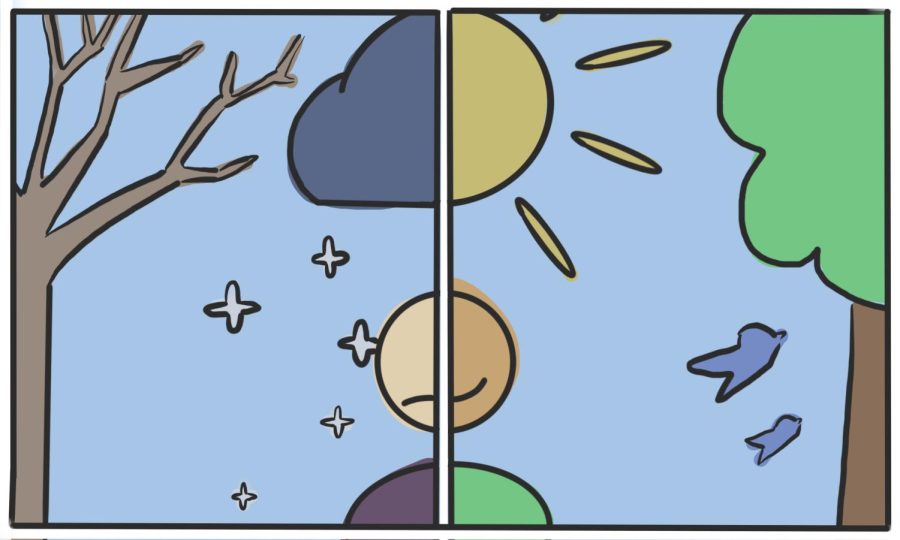A new light on wellness: Students use white light therapy and other methods to alleviate seasonal depression symptoms
A lack of sunlight in the winter means gloomy skies. Evanston’s harsh winters impacted students’ mental health.
February 5, 2023
Bienen and Weinberg sophomore Eloise Brotzman, a California native, did not anticipate the impact the darker Evanston winter and fall months would have on her mental health.
Brotzman noticed that her depression symptoms became more extreme in the winter, but she said using a HappyLight therapy lamp has helped ease her symptoms.
“I use that every morning, usually when I’m getting dressed and when I’m doing my makeup,” Brotzman said. “I’ll just turn it on, and I found that (it) really helps.”
Brotzman is one of many students who use light therapy to counter diagnosed seasonal affective disorder, depression or a general lack of energy based on season.
Feinberg Prof. Dorothy Sit described SAD as recurring episodes of depression that typically begin in the fall and winter and resolve in the spring. Symptoms include lack of motivation, oversleeping, exhaustion, low energy and loss of interest in activities.
Sit led a study that found that individuals with bipolar depression who used white light therapy experienced a greater positive effect than those who did not.
Though Sit supports the use of psychiatric medications to treat seasonal depression, she added that research on light therapy is part of a necessary effort to create more non-drug depression treatment options.
“We can’t have a one-size-fits-all for treatments,” Sit said. “They really need to offer varieties in order to help more people recover from depression.”
One student, who wishes to remain anonymous due to privacy concerns, has been diagnosed with SAD.
They said their non-seasonal depression symptoms increase during the fall and winter months, and that the increase in intrusive thoughts and anxiety can make it difficult to remain present.
“There’s a general sense of lethargy that I notice when it’s cold or gloomy outside,” the student said. “Like, my brain is not really active or awake, which can be in and of itself a bit anxiety-inducing.”
They tried light therapy once but said it was not effective for them because they had “already decided that it wouldn’t work.” However, the student said they were able to manage their symptoms this academic year by creating an exercise routine, practicing intentional eating, breathing and meditation.
The student said they believe preparing early for less light exposure in the fall and winter has helped limit the effects of SAD.
“My first winter here was a huge adjustment (because) I didn’t really recognize that this was seasonal depression,” the student said. “Not being aware of what it was kind of created a formula to exacerbate it far worse than it had to be.”
Students who are not diagnosed with seasonal depression also use white light therapy.
Weinberg freshman Ty’Shea Woods said she bought a light lamp in high school to enhance her mood, productivity and sleep schedule.
“For me, I’ll say it’s just an overall improved mood,” Woods said. “So it’s just like more positive feelings about the day.”
Northwestern offers free white light therapy to students in the Henry Crown Sports Pavilion’s Wellness Suite, according to Assistant Director for Fitness and Wellness Hilary De Vries.
The room consists of chairs, bean bags and a rectangular box of white light that has been filtered against damaging rays. De Vries said she often sees people going into the space with friends.
She added that the space is open to everyone.
“Whether you’re experiencing depression or you’re just not feeling as high of levels of energy, white light therapy has been shown to improve your feelings of wellbeing,” De Vries said. “The idea is to start with low amounts and then you’ll work your way up.”
But, Brotzman said some people may not seek treatment if they are confused about what SAD is.
She said the term seasonal depression is often used by students to describe general feelings of “winter blues,” leading to confusion on when treatment may be necessary.
“I bet that a lot of people also don’t know that they have it,” Brotzman said. “For me, it took moving here to realize that I’m really sensitive that way.”
Email: [email protected]
Twitter: @evdriscoll7
Related Stories:
– NU’s Wellness Suite light therapy alleviates seasonal depression
– White light therapy is now offered at the Henry Crown Sports Pavilion












